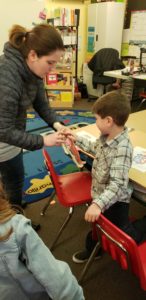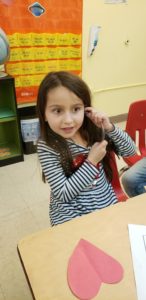La Lectura y Las matemáticas
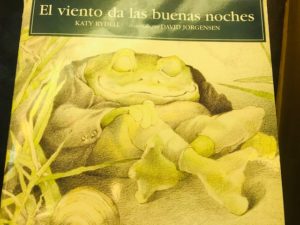 This week we finished our theme about the “El Viento” (The Wind).
This week we finished our theme about the “El Viento” (The Wind).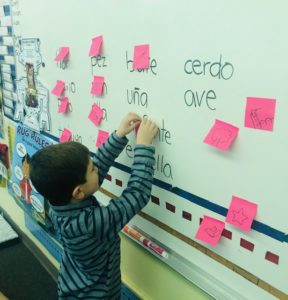 We read the book “El viento da las buenas noches” (The wind says good night) again. The children remembered the characters in the book and commented on the important events and what they thought about them. For me, as a teacher, it was an important exercise for me to really get the sense of how the children are doing in their ability to comprehend when I read the book to them. We continued doing more exercises for them to reinforce their comprehension about the words and full sentences of the read aloud. We worked with images and the corresponding meanings to a set of sentences.
We read the book “El viento da las buenas noches” (The wind says good night) again. The children remembered the characters in the book and commented on the important events and what they thought about them. For me, as a teacher, it was an important exercise for me to really get the sense of how the children are doing in their ability to comprehend when I read the book to them. We continued doing more exercises for them to reinforce their comprehension about the words and full sentences of the read aloud. We worked with images and the corresponding meanings to a set of sentences.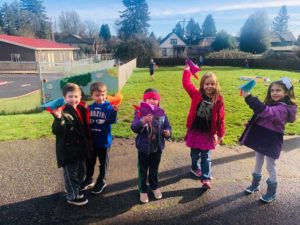
The words of the week were “Agua, Amarillo, Blanco y Corre” (Water, Yellow, White and Run). We made sentences, reading and dictation to help learn the meaning, recognize the words when they hear them and of course, to build their ability to make full sentences with an idea.
“La Manualidad de la semana” (The craft of the week) was to make a bird kite. They used their creativity to decorate, developing their fine motor skills while having fun.
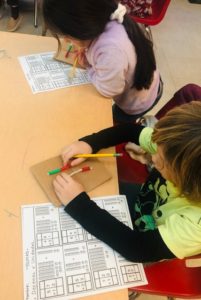 The numbers we were worked with this week were 87 to 91. We worked on recognizing if the numbers are odd or even, identifying tens and ones, and we did a lot of sums to improve their math skills. We also practiced counting 5 by 5 and 10 by 10. Reading written numbers has been also an important exercise we do every week.
The numbers we were worked with this week were 87 to 91. We worked on recognizing if the numbers are odd or even, identifying tens and ones, and we did a lot of sums to improve their math skills. We also practiced counting 5 by 5 and 10 by 10. Reading written numbers has been also an important exercise we do every week.
Science
This week in our new science domain, Seasons and Weather. We discussed winter, both in our local area and in Washington DC, where the character from our lessons is from. We also learned and analyzed a poem about winter. On Monday we had Health with Ms. Bre. The class did some fun activities focusing on heart health.
Our weekly objectives were to:
• name the four seasons in cyclical order, as experienced in the United States, and correctly name a few characteristics of each season
• name at least one holiday in winter
Describe any unique seasonal differences that are characteristic of their own locality in winter ( snow or ice in winter)
• identify ways in which weather affects daily routines, such as dress, activities, Etc.
• describe daily weather conditions of their own locality in terms of temperature (hot, warm, cool, cold); cloud cover (sunny, cloudy); and precipitation (rain, snow, or sleet)
• identify a thermometer as an instrument used to measure temperature how it works – when the liquid in thermometer rises it is hotter outside, when the liquid descends, it is cooler
• demonstrate familiarity with the poem “I Do Not Mind You, Winter Wind”
History & Geography
This week in our new unit, Presidents and American Symbols, we focused on legends and truths about George Washington.
Our weekly objectives were to:
• name George Washington as someone admired for his honesty
• understand that the cherry tree story is a legend
• describe George Washington as a general who fought for American Independence
• recognize that General Washington led his Army to victory even though his army was smaller than the English army
Weekly English Sight Words
could, when, find, must
Specialists
Art with Ms. Kelly
Weather Art Projects
We read Ezra Jack Keats’ famous book A Snowy Day and the children made pictures of themselves making snow angels.
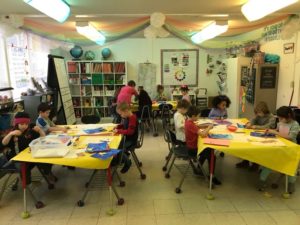 The goals were:
The goals were:
- Learn about the author and illustrator, Ezra Keats
- Paint a snowy background with white, pink, and blue tempera
- Learn how to draw a figure using basic shapes
The students made wonderful snow angel pictures!
We also read Ezra Jack Keats’ A Letter For Amy
The goals were:
- Paint a rainy background using watercolors
- Make a figure of Peter in his raincoat using cut paper
- Learn how to make a “reflection” using oil pastels
These rainy day pictures are almost finished!
Flower Still Life
We read Art From her Heart about folk artist Clementine Hunter, and the students started a still life art project by painting the outline of a vase of flowers. We’ll continue this next week, and you will hopefully see them by Valentines Day!
Music with Ms. Nadia
This month we explored how instruments can mimic animal sounds through Camille Saint-Saëns’ brilliant work, Carnival of the Animals. Each week we read excerpts from a book adaptation, with poems by Jack Prelutsky and illustrations by Mary GrandPré, while listening to the corresponding movement. We then danced to the song as that animal! The first animal, the lion, was represented by a roaring piano and intense strings! We also heard donkey screeching on the violin, birds twittering on the flutes, and a sneaky cat trying to catch fish on the glockenspiel. What do music and animals have in common? Other than creating noises, both are full of contrasts (two opposite things)! Like music, some animals, such as the kangaroos, are fast. Others, such as the elephants, are slow. The song about the cuckoos sounded sad, while the song about the chickens was happy. Swans are graceful and fossils are not so much! Truly, this month was a zoo!
Other January highlights include playing more percussion instruments (drums, maracas, triangle, and tambourine), popping like pop-corn, and chasing bats away with our bear cub Bartholomew during an adventure!

